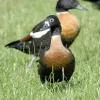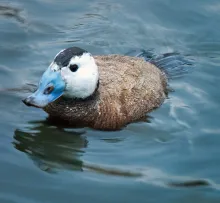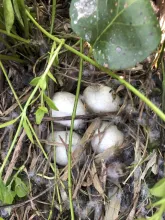
White-Headed duck (Oxyura leucocephala)
Species name
- Dutch name:
- Witkop stekelstaart
- English name:
- White-Headed duck
- German name:
- Weißkopfruderente
- French name:
- Érismature à tête blanche
- Scientific name:
- Oxyura leucocephala
Scientific classification
- Order:
- Anseriformes
- Family:
- Anatidae
- Genus:
- Oxyura
Description
- Description:
Male:
Large head white, with black crown, size emphasized by large bright blue bill with swollen base. Black neck grades to chestnut upper breast; upperparts and flanks chestnut to grayish-chestnut. Finely marked blackish. Uppertail converts chestnut. Lower breast and belly paler, with faint brown barring, becoming whitish to rear, where undertail converts white. Upper wings and tail brown; under wings pale grey, but white on axillaries and inner converts. legs and feet grey-brown.Male non breeding: Less chestnut, more grey-brown, then breeding. Cap dark brown, and extending down to eye and onto nape; Bill Grey.
Female:
Dark chestnut-brown with blackish barring. Upperparts dark brown with grayish speckling. Uppertail converts chestnut. Lower breast and belly paler, with faint brown barring, becoming whitish to rear, where undertail converts white. Upper wings and tail grayish speckling on brown; under wings pale grey, but white on axillaries and inner converts. Bill blue-grayish. Legs and feet grey-brown.Juvenile:
As Female but whiter on head and even more so obvious cheek stripe. White head of adult male not attained until second year.
Standard Measurements
- Body Length (cm):
- The male (drake) of the White-Headed duck measures approximately 43–48 centimeters. The female measures approximately 43–48 centimeters.
- Body Weight (grams):
- The male will weight about 580–750 gram. The female will weight about 580–750 gram.
The weight is notoriously variable and can only be used as indication!
- Note:
The species forms monogamous pair bonds of seasonal duration. The nest is usually located over water in emergent vegetation.
Females lay 4-9 eggs, more usually 5 or 6, at 1.5 day intervals, and may relay if the first clutch is removed. Relative to body mass, lays the largest egg of any waterfowl, and total clutch mass may approach 100% of a female’s non-breeding body weight.- Breeding:
- The female White-Headed duck usually lays from 4-6 eggs and incubates them for 24-26 days.
- Artificial incubating:
The ideal relative humidity for incubating most waterfowl eggs is 55% (ground nesters) and 40% (cavity nesters). The temperature is usually 37.4°C. Set ventilation as recommended by the incubator manufacturer. Eggs must be turned, either automatically or by hand, a minimum of 4 times a day. As the duckling develops there is a loss of water from the egg and the air sac gets bigger. In normal development of an egg with a 24-26 days incubation, the air sac occupies about a third of it three days earlier. Cleanliness is vital and ideally eggs should be moved to a separate hatcher at this point, where the humidity should be increased to 65% and even higher once they have pipped internally.
- Bird banding:
- Recommended closed leg band ring size for the White-Headed duck is 10 mm.The leg band ring can only be applied on a young small stiff-tailed duck at around 12-14 days old.
- It doesn't matter what leg that you band, but it's good to have a consistent system. Suggested: Left leg = Female, Right leg = Male
- Maintenance food:
-





Floating full food for all sea ducks, green ducks, eider ducks and geese, especially in the moulting and breeding phase ideally suited. Packed with wholesome raw materials, natural vitamins and trace elements, this performance food with a protein content of 30% forms the basis for lifelong vitality.
- Regulation:
- No information about regulation available

